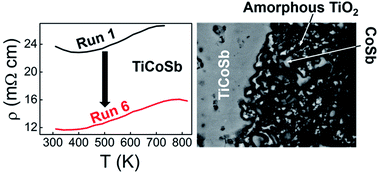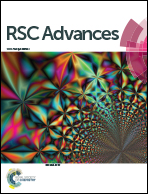Thermoelectric properties and high-temperature stability of the Ti1−xVxCoSb1−xSnx half-Heusler alloys†
Abstract
Half-Heuslers (HHs) are attracting widespread interest for thermoelectric waste heat recovery. This manuscript extends the known TiCoSb based HH compositions and provides new insight into their high-temperature stability. X-ray powder diffraction revealed an upper solubility limit near x = 0.4 for the Ti1−xVxCoSb1−xSnx series. Rietveld analysis of neutron powder diffraction data indicated that TiCoSb is stoichiometric, and confirmed that V and Sn are successfully co-substituted. Scanning electron microscopy revealed small grain sizes (<5 μm) with up to 10–15% Ta along the boundaries due to reaction with the sample containment material. Repeated measurement of the electrical resistivity (ρ) and Seebeck coefficient (S) in a He atmosphere demonstrated that TiCoSb degrades rapidly at elevated temperatures. Scanning electron microscopy and X-ray diffraction reveal the formation of amorphous TiO2 and crystalline CoSb, suggesting that the degradation is driven by exposure to trace amounts of oxygen. The unintentional incorporation of Ta leads to n-type doping and maximum power factors S2/ρ = 0.55 mW m−1 K−2 at 550 K and S2/ρ = 0.8 mW m−1 K−2 at 900 K were observed for TiCoSb and the x = 0.3 sample, respectively.


 Please wait while we load your content...
Please wait while we load your content...